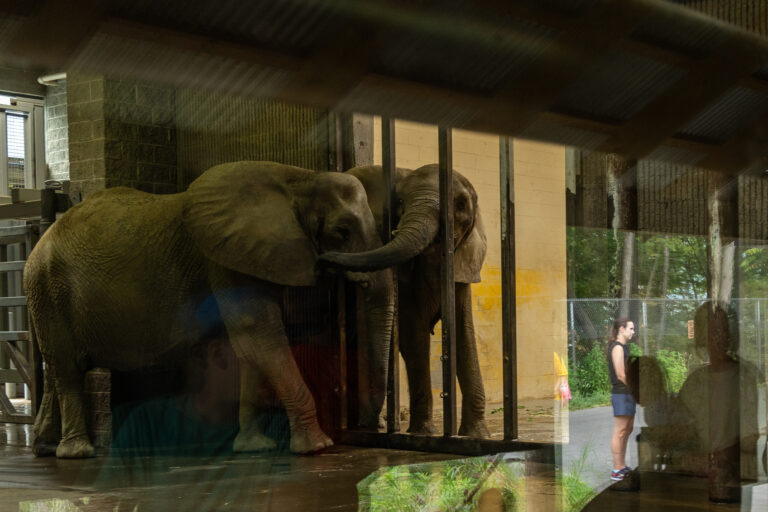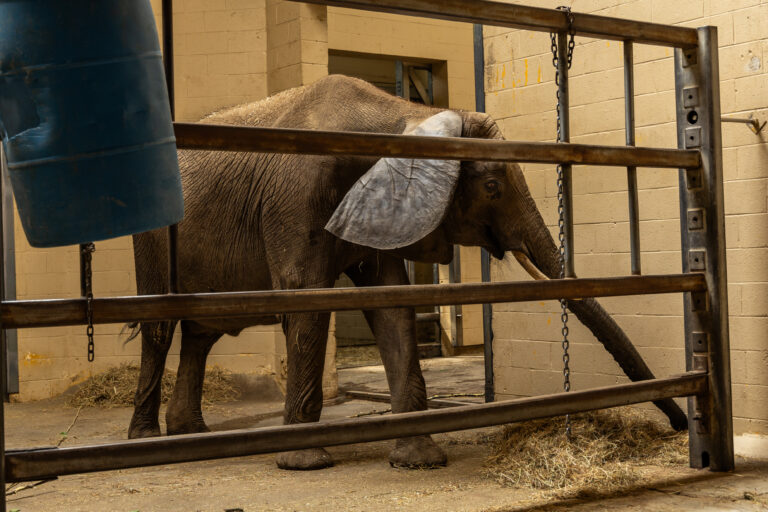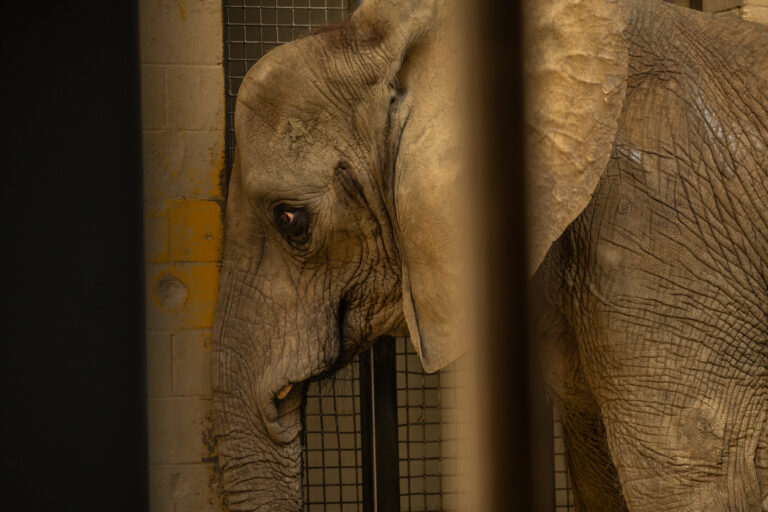
Savanna, Tasha, Angeline, Victoria, and Zuri
There are five female African elephants held in captivity in the Pittsburgh Zoo:
Savanna
Savanna, also known as Nan, is a female African elephant who was born around 1983 in an unknown location in Africa. She was imported to the US in 1986 in the custody of a notorious elephant trainer named Allen Campbell. Campbell is best known for having been killed by an elephant named Tyke after she escaped from a Honolulu stadium following years of abuse and exploitation in a traveling circus. The same year she was imported to the US, Savanna was transferred to Arthur Jones’ “Jumbolair” in Florida.
The inventor of Nautilus exercise equipment and a purported animal lover, Jones imported 63 baby elephants onto his property from Zimbabwe on a Boeing 707 in the mid-80s (elephants were among the many wild animals he confined on his property). He did so in what he stated was an effort to save them from culling by the Zimbabwean government, which NJ.com’s project and investigations team described as a “delusion of grandeur.”
According to Dale Tuttle, a prior director of Springfield Zoo, ten elephants died at the Jumbolair between 1984 and 1987 from transport stress, wounds, and diseases. Most of the elephants were sold to zoos and circuses across the US and Mexico. Savanna was sold to the Miami Metro Zoo in 1990 when she was around seven. Two years later, she was transferred to the Pittsburgh Zoo, where she remains today.
The Pittsburgh Zoo has used her extensively in its elephant breeding efforts. In 1998, she gave birth to a stillborn calf whose father is unknown. Two years later, she gave birth to a male calf named Callee whose father is Jackson. When Callee was ten, the Pittsburgh Zoo transferred him to another zoo. In 2008, Savanna gave birth to Angeline.
A photo taken by Molly Condit for the NhRP in the summer of 2025 shows Savanna and Tasha reaching out to touch trunks through the bars that separate their stalls in the zoo’s elephant barn. A 2012 documentary available to view on Vimeo, Elefamilia, celebrates breeding at the Pittsburgh Zoo and shows Savanna in chains following Angeline’s birth. A bullhook is used on Savanna and thrown at her during and after the birth.
Tasha
Natasha, also known as Tasha, is a female African elephant who was born around 1976 in South Africa. She was captured in 1978 under unknown circumstances and imported to the US in 1979. Where she spent the first two years of her life in the US is unknown. She’s been confined in the Pittsburgh Zoo since 1982. It’s unclear whether the zoo has ever attempted to use Tasha for captive breeding.
Angeline
Angeline is a female African elephant who was born on July 9, 2008 at the Pittsburgh Zoo as part of the zoo’s captive breeding program. Her mother is Savanna and her father is Jackson, also known as Jack, a male elephant confined in the Pittsburgh Zoo’s breeding facility in Fairhope (now called the International Conservation Center, it was previously known as the Fairhope Conservation Center). Angeline has a half-sister named Victoria.
A video recorded by the NhRP in the summer of 2025 shows Angeline chewing on the chains that line a stall in the zoo’s elephant barn.
Victoria
Victoria is a female African elephant who was born on September 12, 1999 in the Pittsburgh Zoo as part of the zoo’s captive breeding program. Her mother is Moja, an elephant previously held captive in the Pittsburgh Zoo. Her father is Jackson. Her sister is Zuri. Victoria is Angeline’s half-sister. Victoria and Zuri have eight living siblings who are held captive in AZA-accredited zoos in Pennsylvania, Florida, Missouri, and Kansas.
When Victoria was three, her mother was walking through the Pittsburgh Zoo elephant exhibit with her at the prompting of a handler with a bullhook. According to one news report, he “urged [Moja] to move along, and the elephant butted him and pinned him to the ground with her head, crushing him.” In 2014, when Victoria was an adolescent, the Pittsburgh Zoo transferred Moja to an AZA-accredited zoo in Oregon where she remains today.
On October 15, 2025, the Pittsburgh Zoo announced that Victoria and Zuri would soon be moved to its breeding center.
Zuri
Zuri is a female African elephant who was born on July 25, 2008 in the Pittsburgh Zoo as part of the zoo’s captive breeding program. Her mother is Moja. Her father is Jackson. The aforementioned film Elefamilia shows Moja soon after Zuri’s birth, reaching out to her baby through the bars that separate them as Zuri stands alone in a cell. Another image shows several elephants vocalizing and reaching out to Angeline through the bars that separate them after Angeline’s birth.
On October 15, 2025, the Pittsburgh Zoo announced that Victoria and Zuri would soon be moved to its breeding center.
About the Pittsburgh Zoo and the elephant exhibit
The Pittsburgh Zoo & Aquarium is a 77-acre facility in Pittsburgh that exhibits more than 8,000 animals representing over 600 species. The zoo is incorporated as the Zoological Society of Pittsburgh and is a wholly private 501(c)(3) entity. It began holding elephants in captivity in 1928.
The Pittsburgh Zoo stands out among US zoos for how long it has used dominance-based elephant management techniques. For example, it used bullhooks on the elephants until the Pittsburgh City Council passed a bullhook ban in 2017. A bullhook is a tool used to control elephants through pain and the fear of pain. In 2014, the USDA cited the Pittsburgh Zoo for using dogs to “nip and charge” the elephants. A year later, the zoo gave up its accreditation by the Association of Zoos & Aquariums (AZA) rather than comply with new safety standards that would prevent handlers from physically interacting with the elephants. Only in 2024 did the Pittsburgh Zoo regain its accreditation after finally agreeing to the new AZA standards.
The zoo actively breeds elephants as part of the AZA’s “Species Survival Plan Program.” Like virtually all zoos accredited by AZA, the Pittsburgh Zoo has a history of forcibly separating elephants, including closely bonded ones.
The most recent elephant death at the zoo was in 2017, when an 11-year-old male elephant named Thabo-Umasai was euthanized because of what the zoo stated was arthritic autoimmune disease.
According to the zoo’s most recent Captive Bred Wildlife Registration submitted to the US Fish and Wildlife Service, the zoo’s elephant exhibits o a 13,500-square-foot barn (called “The Elephant Care Center) which is 130’ by 70’ and a .75 acre outside exhibit yard that has a water feature. The barn is divided into two stalls (30’ x 22’ and 19’ x 25,’ respectively), a “family room” (26’ x 25’), a “bull barn” (34’ x 33’), and a “day stall” (65’ x 45’). Select stalls can be viewed by the public through Plexiglass barriers. There is an outdoor bull pen (40’ x 65’) and an elephant restraining device for medical treatment and semen sampling collection. The barn is constructed of cement block with poured concrete floors.
The zoo describes the outdoor exhibit yard as being .75 acres. It is adjacent to the giraffe exhibit.
The Pittsburgh Zoo has been included on In Defense of Animals’ list of “10 Worst Zoos for Elephants in North America” in 2016, 2017, 2019, and 2020. In early 2025, a Pittsburgh-based national animal advocacy group called the Christian Animal Rights Association created a Change.org petition urging the director of the Pittsburgh Zoo to release the elephants to a sanctuary. It currently has over 13,000 signatures.
Who's joined us in the fight
Donate to support the fight
Donate online
Mail a check
611 Pennsylvania Ave SE #345
Washington, DC 20003
Planned giving
Create a fundraiser
Highlights from the fight
Media coverage
A timeline of Savanna, Tasha, Angeline, Victoria, and Zuri’s case

10.21.25
The NhRP submits a common law habeas corpus petition to the Allegheny County Court of Common Pleas, demanding the right to liberty of five elephants held in captivity in the Pittsburgh Zoo, Case No. GD-25-010963.
The NhRP is also petitioning the Court for injunctive relief to prevent the transfer of two elephants named in the petition, siblings Zuri and Victoria, to the zoo’s breeding center in Fairhope, PA, while the litigation is ongoing.
Elephant cognition and behavior experts Lucy Bates, Richard Byrne, Bob Jacobs, Keith Lindsay, Karen McComb, Cynthia Moss, Mickey Pardo, and Joyce Poole submit declarations in support. Together, their declarations show that elephants are autonomous beings who suffer when deprived of their autonomy in zoos. Brett Mitchell submits a declaration regarding the possibility of the elephants being considered as candidates for rewilding. Download all the expert declarations as a single PDF here.
Habeas corpus is a legal principle that protects against unlawful imprisonment. Common law is used to decide cases that turn on general legal principles—such as liberty and equality—as opposed to those that require interpretation of statutes, constitutions, or treaties. Historically, the common law has been uniquely responsive to evolving standards of morality, scientific discovery, and human experience.
Read the NhRP’s press release here.
11.10.25
Judge Alan Hertzberg hears arguments from the NhRP and the Pittsburgh Zoo on the NhRP’s request for injunctive relief to prevent the transfer of siblings Zuri and Victoria to the zoo’s breeding center while the litigation is ongoing. With no reasons given, Judge Alan Hertzberg issues a ruling from the bench denying the request. During the hearing, lawyers for the zoo announce Zuri and Victoria were already moved. Below is our statement.
During today’s hearing, lawyers for the Pittsburgh Zoo used the same tired arguments and false statements that come up in all our lawsuits to try to prevent our litigation seeking the elephants’ right to liberty from moving forward. They also announced during the hearing that Victoria and Zuri had already been moved to the zoo’s breeding facility. This move was made on October 27th, six days after we filed our lawsuit, with no public announcement. The zoo’s words and actions show that zoo leadership has no concern for the mental and physical anguish these elephants are forced to endure on a daily basis–anguish that’s even worse for the elephants used in captive breeding. The zoo cares only about being in compliance with bare-minimum regulations that preserve the zoo’s ability to deprive elephants of their autonomy. We’ll continue to fight for the elephants’ autonomy to be restored.
